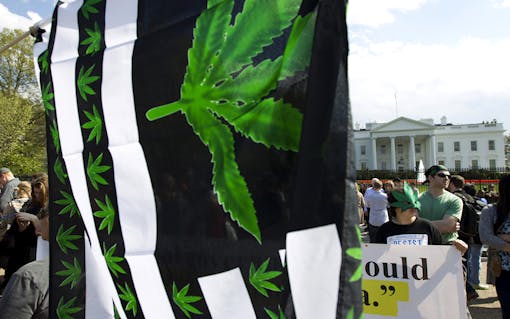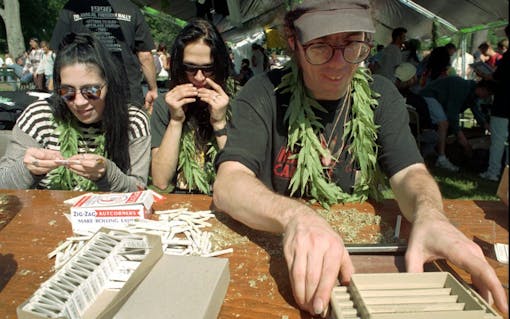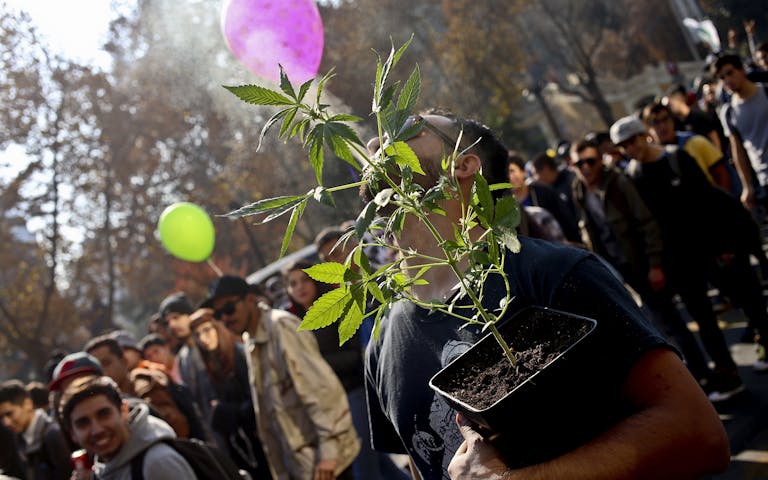The non-violent political uprising that led to the end of communism in the former Czechoslovakia is known as the Velvet Revolution, because the small band of artists, agitators, and political organizers behind that successful push for freedom originally came together to listen to Velvet Underground records (banned under Soviet rule) and party. So it was culture, not conflict, that took down an oppressive and corrupt political regime. This is something that came to mind when I stepped up to speak at the 2016 Cannafest in the Czech Republic.
Cannabis events don’t always get the credit they deserve for the vital role they’ve played in ending prohibition and paving the way to a new era of social acceptability.
Cannabis events don’t always get the credit they deserve for the vital role they’ve played in ending prohibition and paving the way to a new era of social acceptability. Nor do the often anonymous organizers behind these “temporary autonomous zones” get patted on the back enough for pulling off the uniquely difficult feat of bringing together a community that’s been marginalized by fear of arrest, and all too often pushed out of the public square.
Nowadays, in states with legal cannabis, throwing a “weed party” typically involves applying for a “cannabis events license,” but most of the game changers on this list have their roots in a time before legalization. Vivian McPeak, founder of the Seattle Hempfest, has referred to the United States’ largest cannabis gathering as a “protestival,” to highlight his creation’s dual purpose of celebrating the plant and protesting the laws against it. Originally begun as “a humble little gathering of 500 stoners” in 1991, Seattle Hempfest now brings together hundreds of thousands of heads over three days. Its history spans Washington’s transformation from a prohibition state, to a medical cannabis safe haven, to a pioneer of adult-use legalization.
This is no coincidence.
All of the game-changing events on our list have played a major role in pushing forward public perception and catalyzing positive political change by creating a place for the cannabis community to peaceably assemble, share knowledge, make connections, and put a positive public face on an otherwise all-too-invisible culture. Plus, what’s more fun than getting together with fellow cannabis enthusiasts for a high-minded good time?
Hash Bash

Anthony Franciola, left, helps his mother Jeanean Franciola of Manchester, Mich smoke marijuana as he lights her bong during the 33rd annual Hash Bash celebration. Her son helps her smoke because her MS confines her to a wheelchair and she has trouble smoking the bong on her own. (AP Photo/Danny Moloshok)
Location: Ann Arbor, Michigan
In 1969, John Sinclair—poet, agitator, manager of the Detroit rock band MC5, and well-known campus radical—was arrested in an undercover police sting that targeted him based on his political beliefs. Two undercover police officers spent months infiltrating Sinclair’s inner circle, before he finally handed them two joints, which brought down a sentence of ten years in prison.
John Lennon wrote a song about the injustice of it all.
Then in December 1971, the ex-Beatle headlined a “Free John Now” benefit concert and rally. Three days later, Sinclair walked out of prison (after serving two years). Citing the “cruel and unusual punishment” meted out against him, the Michigan Supreme Court went so far as to rule the state’s laws against cannabis unconstitutional.
The following April, the first Hash Bash went down on the University of Michigan Diag in Ann Arbor. The inaugural event was both a celebration of Sinclair’s release and a call to remain ever vigilant in pushing back against prohibition.
“We wanted to have the Hash Bash to defy the law,” Sinclair recalled forty years later to the Ann Arbor News. Penalties for possession had just been lowered from 10 years to one year, and sales from 20-to-life to four years. “[But] we didn’t think that was far enough.”
Shop highly rated dispensaries near you
Showing you dispensaries nearEventually, in the face of ongoing protests and political pressure, Ann Arbor would lower the penalty for possession to a $5 fine (now $25).
Hash Bash returns this April 7th for its 47th incarnation, still starting at high noon, and still on the Diag of the University of Michigan.

Washington D.C. Smoke-In
Location: Washington D.C.
A tradition rumored to be started by the Yippies sometime in the late 1960s (memories are hazy on the exact date), the Washington, D.C. July 4th Smoke-In—held in Lafayette Park across from the White House—takes the idea of blazing a joint as civil disobedience to its logical conclusion. After all, what better symbolism of the people’s power over the government and its wrongheaded prohibition could you ask for than a mass of citizens gathering together, on the nation’s birthday, to openly defy the law in plain view of the President’s home?
They took a “safety in numbers” approach to the festivities, working tirelessly to recruit enough brave souls so that when they all lit up at once, the police would be powerless to intervene.
Led by political pranksters like Abbie Hoffman, Jerry Rubin, and Paul Krassner, the Yippies backed any number of radical causes in the 60s and 70s, from cannabis legalization to ending the Vietnam War, dismantling capitalism, and disbanding the FBI, the CIA, and the DEA. At the Smoke-In, they took a “safety in numbers” approach to the festivities, working tirelessly to recruit enough brave souls so that when they all lit up at once, the police would be powerless to intervene against so many gleeful lawbreakers.
The Washington Postfirst reported on the Smoke-In in 1977, noting:
The marijuana demonstrators listened to rock music, bathed in fountains, tossed Frisbees, occasionally taunted the police, displayed protest signs and climbed atop a park statue. Some also smoked marijuana… Though marijuana smoke at times filled the air and a few minor incidents occurred, police reported they had made no arrests.
“With the numbers they have, (estimated at upward of 3,000) the policy is to control the crowd,” said Deputy U.S. Park Police Chief Parker T. Hill, “We’re not concerned with minor infractions.”
By 1982, however, Ronald Reagan was fully installed in the White House, and old Dutch took a predictably dim view of the event. As the Washington Post reported:
Shed no tears, please, but a Fourth of July tradition in Lafayette Park has been snuffed out–at least officially–by the powers that be… For the first time in more than a decade, the park is not officially scheduled to be the scene of a marijuana smoke-in sponsored by the Youth International Party, commonly called the Yippies. Its highlights have included the burning not only of marijuana, but also of hundreds of blank Selective Service registration cards.
The Yippies assure us that they themselves are not burned out, though—they just got burned this year, by a coalition of civic, church, family, school and anti-drug groups [who got] a permit to reserve the park. Their celebration promises to be quite different: a “National Family Day” is being planned, sponsored by the National Federation of Parents for Drug-Free Youth, the D.C. Congress of Parents and Teachers, the local chapters of Toughlove and Straight, Inc., and dozens of other organizations.
Basically, a bunch of human paraquats stole the Smoke-In.
But fear not, the July 4th tradition would return, and even added a parade through the streets of the nation’s capital, with chants ranging from “We smoke pot, and we like it a lot,” to “Free the heads, jail the Feds.”
Amsterdam Cannabis Cup

Visitors to the week-long cannabis festival in Amsterdam line up to sample marijuana on Thursday November 27, 1997. About 2,000 marijuana lovers, many of them from the United States, are in the drug-tolerant Dutch capital for the yearly blowout. (AP Photo/Sjoerd van Delden)
Location: Amsterdam, Netherlands
Started in 1988 by High Times editor Steven Hager as a small private affair among a select few Amsterdam coffeeshops and cannabis breeders, the Cannabis Cup eventually evolved into a world famous, week-long competitive event. It came to draw thousands of enthusiasts, from dozens of countries, on a pilgrimage to judge the finest cannabis and make some like-minded new friends without having to worry about the police—all in one of the most beautiful and cannabis-tolerant cities on earth.
Each year, Cup-goers voted on their favorite cannabis entered by the coffeeshops. Winning strains in the competition became stars overnight, helping to spread the hottest new varietals globally. Meanwhile, the latest innovations (grinders, vaporizers, clear rolling papers) were debuted at an expo overflowing with booths from seed companies and paraphernalia makers. It was the cannabis industry before there was a cannabis industry.
Over the years, the Cup also featured incredible music performances from Patti Smith, Redman, Fishbone, Busy Bee, and more. The event was discontinued in 2014 after repeated problems with the Dutch government, but will return this July.
Emerald Cup
Location: Santa Rosa, California
The first major cannabis cultivation competition to focus exclusively on organic, outdoor flowers, The Emerald Cup started in 2003 as a small, local competition among Northern California’s top cannabis growers. Bringing together legends of the underground from throughout the famed “Emerald Triangle” (comprised of Humboldt, Mendocino and Trinity Counties), the annual event was held for many years at Area 101, a cannabis events center later transformed into a dispensary.
Nowadays, the Emerald Cup is held over three days at the Sonoma County Fairgrounds. With top flight speakers, panelists, and entertainment (Damian Marley, The Roots, Beats Antique have all headlined) as well as hundreds of booths, they’ve grown into a huge, dynamic event while still maintaining a strong connection to their roots in the cannabis underground.
Called “the Academy Awards of the cannabis industry,” The Emerald Cup’s annual contest to find California’s best cannabis flowers, concentrates, topicals, and edibles is considered the industry’s most prestigious (if not the best marketed).
Boston Freedom Rally

Herb cigarette vendors, including from the left, Veronika Alexander and Alyn Cornell of East Greenwich, Mass., and Jay Morgan, of Boston, roll cigarettes made from an herb they identified as mugwort Saturday, Sept. 21, 1996, at the annual Freedom Rally. Morgan explained that his group made and sold the herb cigarettes to confuse the police as to who was or was not smoking marijuana. (AP Photo/Steven Senne)
Location: Boston, Massachusetts
The very first Freedom Rally took place in 1989, in North Adams, a small town in the Berkshires. The next year, the event scaled up a bit and moved to a dock beside the USS Constitution. Then it was staged in front of the Massachusetts State House. Finally, the Boston Freedom Rally arrived at its current home, Boston Commons.
“The city has no good reason not to like our event. We bring in lots of money and we’ve never had any problems.”
With cannabis now fully legal for all adults 21-and-over in Massachusetts, the event has grown into a huge celebration, with tens of thousands of attendees basking in three days of speakers, music, vendors, and herbal freedom. For the East Coast, it’s always been the premiere event showcasing cannabis in a positive light and pushing for legalization.
But that kind of freedom didn’t come easy.
Over the last 30 years, the cannabis activists organizing the event have had to sue the city of Boston six times for the right to throw a “political and education rally” in the Commons, the oldest city park in the United States.
“The city has no good reason not to like our event. We bring in lots of money and we’ve never had any problems,” Bill Downing, a Member Liaison for MassCann/NORML and one of the organizers of the rally, told Boston College Heights in 2017. “But the city really does not like us.”
In 2007, police at the event arrested then High Times associate publisher Rick Cusick and NORML founder Keith Stroup for (allegedly) smoking a joint while waiting to speak to a crowd of thousands at the Rally.
Naturally, this dynamic duo went out and got Charles Nesson, a Harvard law professor and one of the most famous litigators in the country, to take their case, which they hoped to bring all the way to the Supreme Court (as a test case for the concept of jury nullification).
That didn’t happen, but it’s a hell of a story anyway.

Seattle Hempfest
Location: Seattle, Washington
Springing directly from the city’s grassroots cannabis community, the inaugural Seattle Hempfest took place in 1991 at Volunteer Park, and drew a few hundred grizzled hippies and punks.
For the first three years, not a single uniformed police officer set foot inside. In 1994, however, that changed when the event grew so large it began to concern city officials for reasons beyond rampant pot smoking. According to the Hempfest website:
A growing concern from police, parks department, and neighborhood groups would be reflected in a series of negotiations that would span many months and involve as many subcommittee meetings to determine our ability to meet the new demands of the Special Events Permit that was now required of us. The negotiations culminated with assistance from the ACLU, and required a $1,000,000 insurance policy, the addition of hired licensed, bonded and insured security, emergency evacuation plans, an on-site ambulance and paid EMTs. Meetings with concerned community groups soon followed, helping to establish Hempfest as a legitimate political rally, not merely a “pot party in the park,” as had been previously claimed by our critics.
Proving themselves up to the challenge, Hempfest organizers found a way to scale up exponentially while meeting all of these increasing demands from the city. Along the way, a mutual respect developed between the freaks and the squares that led to Seattle becoming one of the most progressive cities in the nation on cannabis issues. In 2010, Seattle City Attorney Pete Holmes announced his office would no longer file cannabis charges. This year, he joined Seattle’s mayor in moving to dismiss hundreds of past cannabis misdemeanors.
Ironically—and bitterly so—Hempfest has struggled to keep up with the staggering cost of throwing the event in the era of legalization. Unable to charge even a modest admission price without threatening their status as a “constitutionally protected free speech event,” Hempfest has recently lost a large number of its major financial backers, as new regulations on licensed cannabis businesses in the state of Washington prevent them from continuing to donate.
But the show will most definitely go on, this August 17-19 in Seattle’s Myrtle Edwards Park. No doubt bigger and better than ever.
Cannafest
Location: Prague, Czech Republic
Billed as an “international trade show of cannabis and medical herbs,” Cannafest in the Czech Republic has grown over the last seven years from a small local event to one of the largest and best attended cannabis fairs in the world.
Most of Eastern Europe remains mired in a prohibitionist mindset, but thanks to the activists behind Cannafest, the Czech Republic is leading the way towards legalization.
Held in the breathtaking Prague Exhibition Grounds (built for the Jubilee Exhibition of 1891), Cannafest now draws over 250 vendors and 25,000 cannabis enthusiasts from all over the world. They attend seminars, take educational classes, and meet scientists, researchers, growers, and other cannabis thought leaders from around the world.
“Every year, we’ve worked hard to bring renowned experts from the US, Israel, Spain, and other countries to Prague to give lectures during our professional conference,” Cannafest director Lukáš Běhal told Leafly, noting that the most recent event spanned four exhibition halls totaling 41,000 square feet. Most of Eastern Europe remains mired in a prohibitionist mindset, but thanks to the activists behind Cannafest, the Czech Republic is leading the way towards legalization.
Laws in Prague aren’t particularly harsh (especially for Eastern Europe), but definitely note that cannabis remains illegal. Visitors caught consuming in public or in possession of less than 10 grams of dried flower usually get away with a $60 fine. Police—both uniformed and undercover—maintain a heavy presence at Cannafest. They don’t seem particularly fun-loving in their demeanor, but don’t let that deter you from visiting one of the world’s most beautiful cities, a center of culture with a long history of resistance.
Cultivate Your Rights

A man smokes while carrying a cannabis plant during a march for the legalization of marijuana, in Santiago, Chile, Saturday, June 3, 2017. Tens of thousands of people gathered in the central streets of Santiago to demand that the government change its policy regarding marijuana and self-cultivation. (AP Photo/Esteban Felix)
Location: Santiago,Chile
In many ways, Chile is known as one of the more socially conservative countries in Latin America. But not when it comes to cannabis. In fact, Chileans consume more cannabis per capita than any other country in Latin America. And they’ve been moving ahead politically as well, especially when it comes to decriminalization and medicinal use.
Every April in Santiago, the capital, huge crowds gather for “Cultiva Tus Derechos” (“Cultivate Your Rights”), a protest march and freedom festival that continues to grow each year, bringing together the local cannabis community to feel its strength in numbers, while putting a spotlight on an issue that’s been considered taboo for too long.
Thanks in part to the hard work of event organizers Movimental, and the team at RevistaCanamo magazine, Chile decriminalized cannabis in 2015, has begun allowing limited non-profit compassionate medical cannabis cultivation, and has even approved medical cannabis sales in pharmacies.
Lead image: Esteban Felix/AP
Flood image 1: Jose Luis Magana/AP
Flood image 2: Elaine Thompson/AP





